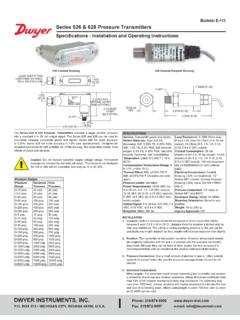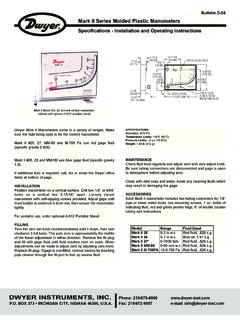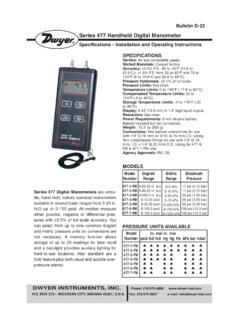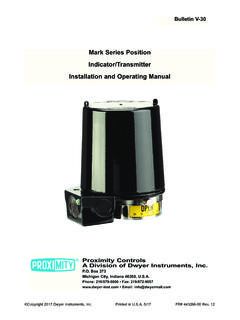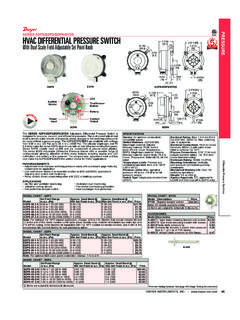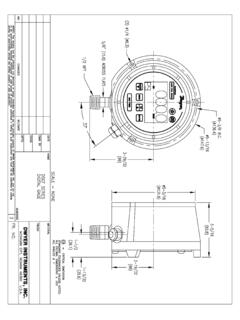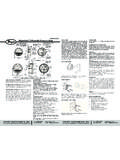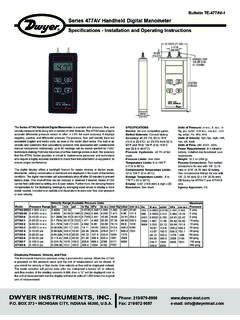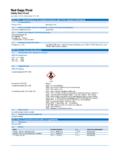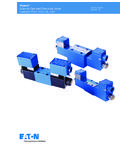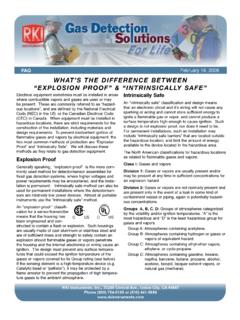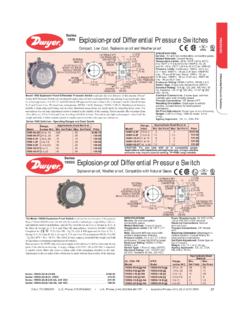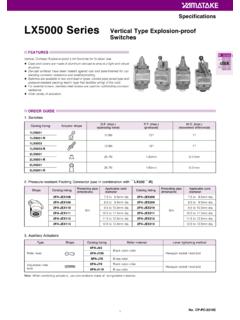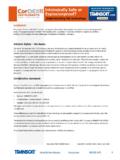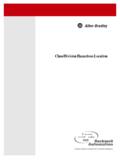Transcription of Series 1950 Explosion-Proof Differential Pressure …
1 At Min. Set Set psiSeries 1950 Explosion-Proof Differential Pressure Switches com-bine the best features of the Series 1900 Pressure Switch with an inte-gral Explosion-Proof and weather- proof housing. Each unit is UL &CSA listed; FM approved for use in Class I, Groups C Class II,Groups E, F, and Class III atmospheres (NEMA 7 & 9). They aretotally rain-tight for outdoor installations. Twelve models allow set-points from .03 to 20 inches and from .5 to 50 psi ( to 345 kPa).Easy access to the SPDT switch for electrical hook-up is provided byremoving the top plate of the three-part aluminum housing.
2 Adjustmentto the set point of the switch can be made without disassembling thehousing. The unit is very compact, about half the weight and bulk ofequivalent conventional Explosion-Proof : Air and non-combustible, compatible Materials: Consult Limits: -40 to 140 F (-40 to 60 C); 0 to 140 F ( to 60 C) for 1950P-8, 15, 25, and 50. -30 to 130 F ( C) for Limits: Continuous: 1950 s - 45 ( bar);1950P s - 35 psi ( bar); 1950P-50 only - 70 psi ( bar). Surge: 1950 s - 10 psi ( bar), 1950P s - 50 psi ( bar), 1950P-50only - 90 psi ( bar).Enclosure Rating: IP54, NEMA 3, 7 and Type: Single-pole double-throw (SPDT).Electrical Rating: 15 A @, 125, 250, 480 VAC, 60 Hz.
3 Resistive 1/8HP @ 125 VAC, 1/4 HP @ 250 VAC, 60 Connections: 3 screw type, common, normally open andnormally Connections: 1/8 female Orientation: Diaphragm in vertical position. Consult factoryfor other position Point Adjustment: Screw type on top of : Ib ( kg); 1950-02 model, lb (2 kg). Agency Approvals: CE, UL, CSA, TIME:Because of restrictive effect of flame arrestors,switch response time may be as much as 10-25 seconds where appliedpressures are near set 1950 Explosion-Proof Differential Pressure SwitchesSpecifications - Installation and Operating InstructionsBulletin E-57UL and CSA Listed, FM Approved ForCL.
4 I GR. C, D - CL. II GR. E, F, G - CL. IIIS eries 1950 Switches Operating ranges and deadbandsTo orderspecifyModel Number1950-02-2S1950-00-2F1950-0-2F1950- 1-2F1950-5-2F1950-10-2F1950-20-2 FModel Number1950P-2-2F1950P-8-2F1950P-15-2F195 0P-25-2F1950P-50-2 FOperatingRange:Inches, to to to to to to to : to to to to to 50 ApproximateDead BandDWYER INSTRUMENTS, INC. Phone: 219/879-8000 BOX 373 MICHIGAN CITY, INDIANA 46361, Fax: 219/872-9057e-mail: use only with air or compatible gases. Use of the Model 1950switch with explosive media connected to the Low Pressure port(including Differential Pressure applications in such media) is not rec-ommended.
5 Switch contact arcing can cause an explosion inside theswitch housing which, while contained, may render the switch inoper-ative. If switch is being used to sense a single positive Pressure rela-tive to atmosphere, run a line from the low Pressure port to a non-haz-ardous area free of combustible gases. This may increase responsetime on -0 and -00 : The last number-letter combination in the model number identi-fies the switch s electrical rating (number) and diaphragm material (let-ter). The 2F combination is standard as described in the physical dataabove. In case of special models, a number 1 rating is the same as 2;a number 3 or 4 rating is 10A 125, 250, 480 VAC; 1/8 125 VAC; 1 250 VAC; a number 5 or 6 rating is 1A 125 VAC.
6 Letter B indicatesa Buna-N diaphragm; N = Neoprene; S = Silicone; and V = Viton .At Max. Set Set psiApproximate Dead BandSet Point Adjustment Screw1/2 ( )female NPTE lectrical Conduit ConnectionINSTALLATION1. Select a location free from excess vibration and corrosive atmos-pheres where temperatures will be within the limits noted underSpecifications on reverse. Switch may be installed outdoors or in areaswhere the hazard of explosion exists. See reverse for specific types ofhazardous Mount standard switches with the diaphragm in a vertical plane andwith switch lettering and nameplate in an upright position.
7 Some switch-es are position sensitive and may not reset properly unless they aremounted with the diaphragm Connect switch to source of Pressure , vacuum or Differential tubing with 1/4 is recommended, but any tubing which willnot restrict the air flow can be used. Connect to the two 1/8 female NPTpressure ports as noted below:A. Differential pressures - connect pipes or tubes from sourceof greater Pressure to high Pressure port marked HIGH PRESS, and from source of lower Pressure to low Pressure port marked LOW Pressure only (above atmospheric Pressure ) - connect tube from source of Pressure to high Pressure port.
8 The low Pressure port is left open to Vacuum only (below atmospheric Pressure ) - connect tubefrom source of vacuum to low Pressure port. The highpressure port is left open to To make electrical connections, remove the three hex head screwsfrom the cover and after loosening the fourth captive screw, swing thecover aside. Electrical connections to the standard single pole, doublethrow snap switch are provided by means of terminals marked COM (common), NO (norm open), NC (norm closed). The normally opencontacts close and the normally closed contacts open when pressureincreases beyond the set point. Switch loads for standard models shouldnot exceed the maximum specified current rating of 15 amps capabilities decrease with an increase in ambient temperature,load inductance, or cycling rate.
9 Whenever an application involves oneor more of these factors, the user may find it desirable to limit theswitched current to 10 amps or less in the interest of prolonging : To Change the Set point1. Remove the plastic cap and turn the slotted Adjust-ment Screw at thetop of the housing clockwise to raise the set point Pressure and counter-clockwise to lower the set point. After calibration, replace the plastic capand re-check the set The recommended procedure for calibrating or checking calibration isto use a T assembly with three rubber tubing leads, all as short as pos-sible and the entire assembly offering minimum flow restriction.
10 Run onelead to the Pressure switch, another to a manometer of known accuracyand appropriate range, and apply Pressure through the third tube. Makefinal approach to the set point very slowly. Note that manometer andpressure switch will have different response times due to different inter-nal volumes, lengths of tubing, fluid drainage, etc. Be certain the switchis checked in the position it will assume in use, with diaphragm in avertical plane and switch lettering and Dwyer nameplate in an For highly critical applications check the set point adjustment and ifnecessary, reset it as noted in step moving parts of these switches need no maintenance or only adjustment is that of the set point.
